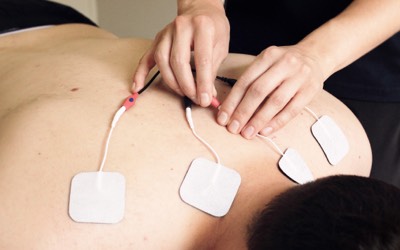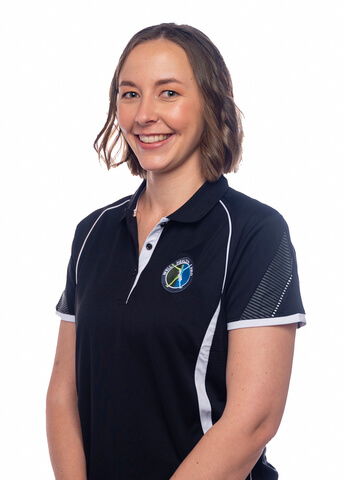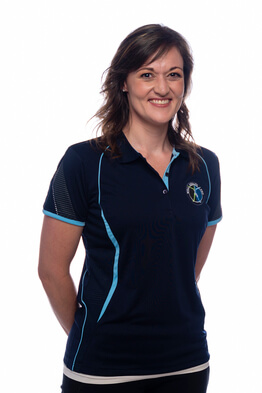TENS is an acronym for Transcutaneous Electrical Nerve Stimulation, which is medical jargon for applying an electrical current on your skin to stimulate your nerves. Though it may sound like something from 1800’s Frankenstein, if a TENS machine is used by a professional it feels comfortable and aids your healing.
Electrodes are placed on your skin to allow the current to move from one electrode to the other. TENS machines are mainly used for pain relief during your physiotherapy treatment.
What exactly is TENS treatment?
TENS is a non invasive method of pain relief, which means nothing enters your body, no needles and no medication. The use of TENS is an extremely popular method of pain relief. It is relatively cheap, easy to use, and has minimal side effects when compared to oral medication. TENS provides short-term pain relief, giving the window of opportunity to address other contributors and compensations due to an injury. TENS can relieve 70% of pain in an acute injury.
Why we use TENS machines
TENS relieves pain. Now that we have established a more comfortable state for your joints, muscles and nerves we can address any contributing factors of your problem, use joint mobilisations and start gentle range of motion exercises. Ultimately we aim to get you moving safely as soon as possible to accelerate healing. TENS is never used in isolation. It is part of a holistic approach to get you back doing what you love, in as little time as possible.
Healing Effects of TENS
- accelerates healing
- decreases stiffness
- relieves pain
- reduces inflammation
- increases circulation
- improves range of motion
- provides pain relief to initiate rehabilitation
“One of the most powerful machines to relieve pain”
Different types of TENS treatment
We can apply different “doses of TENS” with specific settings to the TENS machine, specific to your problem. Most TENS machines have the following variables:
- Frequency: Most machines offer a frequency of approximately 2-200 Hz. To stimulate the mechanoreceptors the frequency should usually be in the region of between 90-130Hz.
- Intensity: The intensity of the current is also adjustable and most machines will be able to reach intensities of between 80-100mA.
- Pulse Width: This setting controls the period of time that electrical currents pass through the electrodes. Many professionals place less emphasis on this setting than the intensity and frequency while some machines do not even have this particular control.
Low vs High frequency TENS treatment
Deciding on the frequency of your “TENS dose” is specific to your problem. High frequency TENS (50 Hz and up) works on a sensory mechanism by activating the gate theory to relieve pain. Low frequency TENS (lower than 50 Hz) works on a chemical level by stimulating the release of endogenous opioids to relieve pain.
What happens to the tissue during TENS treatment?
TENS relieves pain mainly by stimulating the pain gate mechanism. When tissue is injured, nociceptors (pain receptors) in the area become increasingly sensitive. This causes a heightened perception of pain in the area. This is similar to how sore and sensitive your skin feels after sun burn. In the same area, there are also a number of mechanoreceptors that respond to touch. When we stimulate the mechanoreceptors it overrides the pain impulses from that area, this is known as the pain gate mechanism. These mechanoreceptors are stimulated by high frequency TENS (usually 90-130 Hz) and provide pain relief.
Changes on a cellular level:
While the pain gate mechanism achieves pain relief for the injured tissue, TENS application also stimulates the release of our bodies’ own pain killers. Endogenous opioids are released by nerve cells when low frequency TENS is applied. Endogenous opioids include endorphins, enkephalins and dynorphins. The misuse of oral opioids will alter the efficacy of TENS treatment. Endogenous opioids also have the added benefits of influencing motivational and mood processes and positively influence endocrine, respiratory, autonomic and immune responses.
What does TENS feel like?
If TENS is beneficial for the condition you have we will begin by explaining the benefits of the treatment and ask for consent. Then we expose the area to be treated, and place self-adhesive electrodes in specific positions. We then calibrate the TENS machine for the correct settings, for your specific problem, and switch it on. It feels like a gentle, tingling vibration through your muscles. It is not painful at all. Each person is different and it is important to adjust the intensity of treatment to gain the maximal effect from the machine, while still working within your threshold.
How long does TENS application take?
TENS can be applied from 5 -30 minutes. So that we don’t waste precious treatment time, TENS can be applied while working on a different structure. Each dosage is specific to your unique condition and the phase of healing that you are in at that point in time.
How many times should I get TENS machine treatment?
You could feel the effect of the TENS therapy after the first session, however it works best if it can be administered repeatedly for a few weeks. It can be used in each treatment session.
Your physiotherapist will discuss a treatment plan with you, we’ll give you an idea of how long it will take for your condition to improve and how often treatment is needed. Some cases we’ll need 6-8 sessions. Mostly we see you twice during your first week, and once a week for the next two weeks and then once every second week in the next month.
What can I do at home after TENS treatment?
Follow your physiotherapist’s advice after your treatment session. Your home exercise prescription will be specific to your unique situation. While you experience the pain relief from TENS you can do your range of motion and strengthening exercises and stretches. Don’t over do your routine, because you are bound to feel much better after TENS application.
There are a few things you can do at home:
- Stretch the surrounding tissue
- Apply heat / ice to help with pain (your physio will advise you which one to use)
- Do your prescribed home exercises
Cost of TENS treatment
There are certain medical aid rates for using a TENS machine as a treatment, but it is always used as part of a complete treatment consultation. So, you will never be paying for only TENS.
This treatment in isolation will not fix your problem. It’s the complete treatment package that shows the real improvement.
Medical Aid Code – 103
TENS machine application treatment code is 103. We don’t use TENS in isolation. We can apply TENS while working on muscle and nerve structures too. Most medical aids cover TENS machine usage.
Does experience make a difference when using TENS?
Just like you would feel more comfortable with an experienced electrician working in your home, the experience of your physiotherapist makes a difference when using TENS. We will explain the dosage and procedure to you. Our physiotherapists will teach you how, when and where to apply TENS at home if you wish to purchase your own TENS machine.





